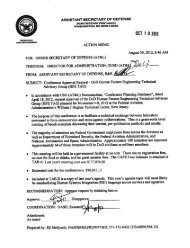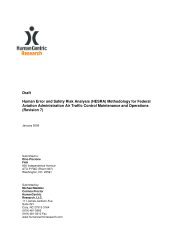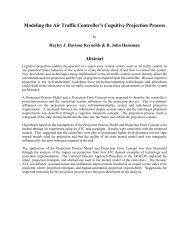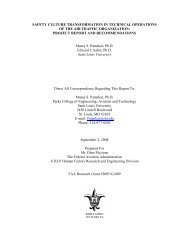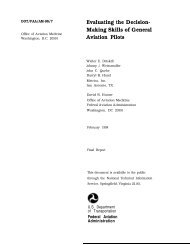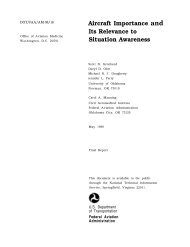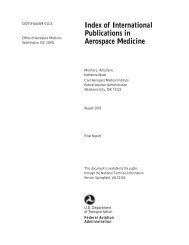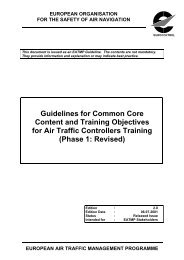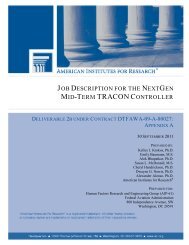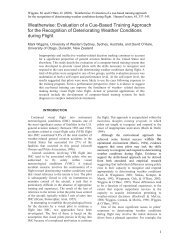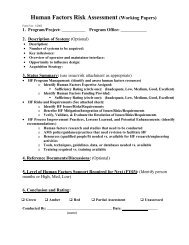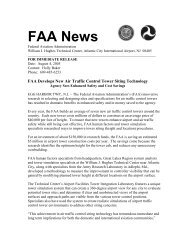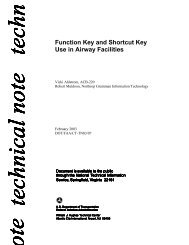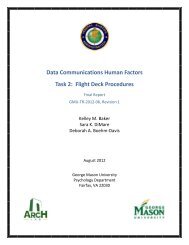job description for the nextgen mid-term atct controller - FAA Human ...
job description for the nextgen mid-term atct controller - FAA Human ...
job description for the nextgen mid-term atct controller - FAA Human ...
You also want an ePaper? Increase the reach of your titles
YUMPU automatically turns print PDFs into web optimized ePapers that Google loves.
In addition to actively controlling <strong>the</strong> aircraft and vehicles in <strong>the</strong>ir area of responsibility,<br />
<strong>controller</strong>s respond to requests <strong>for</strong> route and flight plan deviations and provide severe wea<strong>the</strong>r<br />
avoidance (using <strong>the</strong> Low Level Wind Shear Alert System [LLWAS]), fuel optimization<br />
planning, and noise abatement to achieve optimized flow scenarios. They may provide<br />
additional services on a workload-permitting, case-by-case basis; <strong>the</strong> provision of <strong>the</strong>se services<br />
is subject to <strong>the</strong> <strong>controller</strong>’s discretion. For example, <strong>controller</strong>s may per<strong>for</strong>m visual flight rule<br />
(VFR) flight following Tasks and amend flight plans. In addition, o<strong>the</strong>r in<strong>for</strong>mation is<br />
<strong>for</strong>mulated and issued in <strong>the</strong> <strong>for</strong>m of advisories, which can be ei<strong>the</strong>r general or specific, such as<br />
turbulence or bird activity notifications.<br />
ATCT line <strong>controller</strong>s must give equal consideration and balance individual operational needs<br />
with <strong>the</strong> needs of an entire system. To do this effectively, <strong>the</strong>y must have access to near realtime<br />
and accurate in<strong>for</strong>mation, which allows <strong>the</strong>m to remain flexible and effective in maximizing<br />
operations. As <strong>controller</strong>s provide and manage separation, <strong>the</strong>y are also responsible <strong>for</strong><br />
resolving conflicts within <strong>the</strong> system.<br />
Current ATCT Activity 5: Resolve Conflicts<br />
ATCT line <strong>controller</strong>s strive to actively prevent or mitigate conflicts to give system users <strong>the</strong><br />
ability to react in a timely manner. Their goal is to prevent such occurrences, or to reduce <strong>the</strong><br />
likelihood of such occurrences, as <strong>the</strong>y manage air traffic. However, conflicts can occur between<br />
two aircraft, between an aircraft and <strong>the</strong> ground, and between aircraft and airspace and can occur<br />
when vehicles or aircraft fail to con<strong>for</strong>m to instructions. These occurrences can be <strong>the</strong> result of<br />
errors in judgment by any of <strong>the</strong> many participants in <strong>the</strong> NAS or as a result of un<strong>for</strong>eseen<br />
circumstances, including severe wea<strong>the</strong>r, emergencies, or o<strong>the</strong>r unusual circumstances.<br />
After a potential or actual conflict is identified, <strong>controller</strong>s de<strong>term</strong>ine its validity by using several<br />
different methods. The method used depends partly on <strong>the</strong> facility’s unique configuration and<br />
<strong>the</strong> availability of tools and equipment. First, <strong>controller</strong>s may use an OTW view to scan airport<br />
movement areas or nearby airspace to de<strong>term</strong>ine whe<strong>the</strong>r a conflict exists. Second, <strong>controller</strong>s<br />
may listen to and verify readback from pilots regarding a potential or actual conflict via <strong>the</strong><br />
RDVS/ETVS. Third, if available, <strong>controller</strong>s may monitor radar displays (e.g., D-<br />
BRITE/RACD/Tower Display Workstation [TDW]) <strong>for</strong> minimum safe altitude warning<br />
(MSAW) alerts, converging course in<strong>for</strong>mation, and traffic conflictions. Finally, if an ATCT<br />
facility has ASDE-X, <strong>controller</strong>s may scan its display <strong>for</strong> potential surface area incursions.<br />
These steps <strong>for</strong> de<strong>term</strong>ining <strong>the</strong> validity of a conflict are not mutually exclusive.<br />
Once <strong>the</strong> validity of <strong>the</strong> conflict has been verified, <strong>the</strong>n <strong>controller</strong>s issue alerts or advisories via<br />
<strong>the</strong> RDVS/ETVS with a specific <strong>description</strong> (e.g., traffic, severe wea<strong>the</strong>r, unsafe conditions)<br />
using radio or landlines. After issuing advisories or safety alerts, <strong>controller</strong>s continue to monitor<br />
<strong>the</strong> aircraft as it maneuvers through movement areas or nearby airspace using <strong>the</strong> OTW view if<br />
visibility permits or via radar or surface surveillance (e.g., ASDE-X) displays. Controllers<br />
monitor movements to ensure that operators comply with issued instructions and that <strong>the</strong><br />
situation has been resolved.<br />
Conflict mitigation is <strong>the</strong> ATCT line <strong>controller</strong>’s primary responsibility. All available system<br />
procedures and resources are focused on <strong>the</strong> recognition and mitigation of conflicts. Although<br />
conflicts cannot be eliminated entirely in complex systems like <strong>the</strong> NAS, <strong>the</strong>y can be resolved on<br />
22



